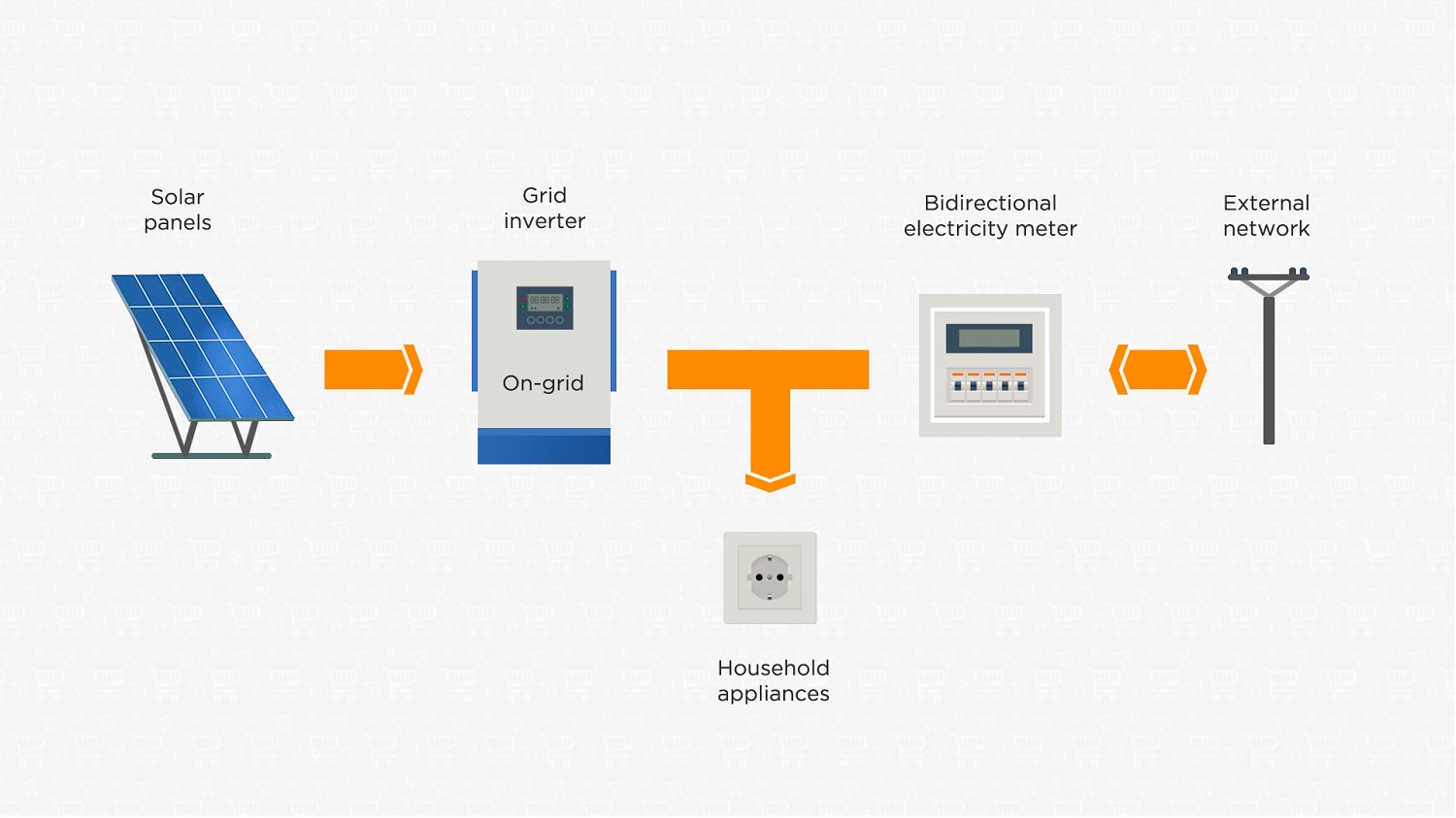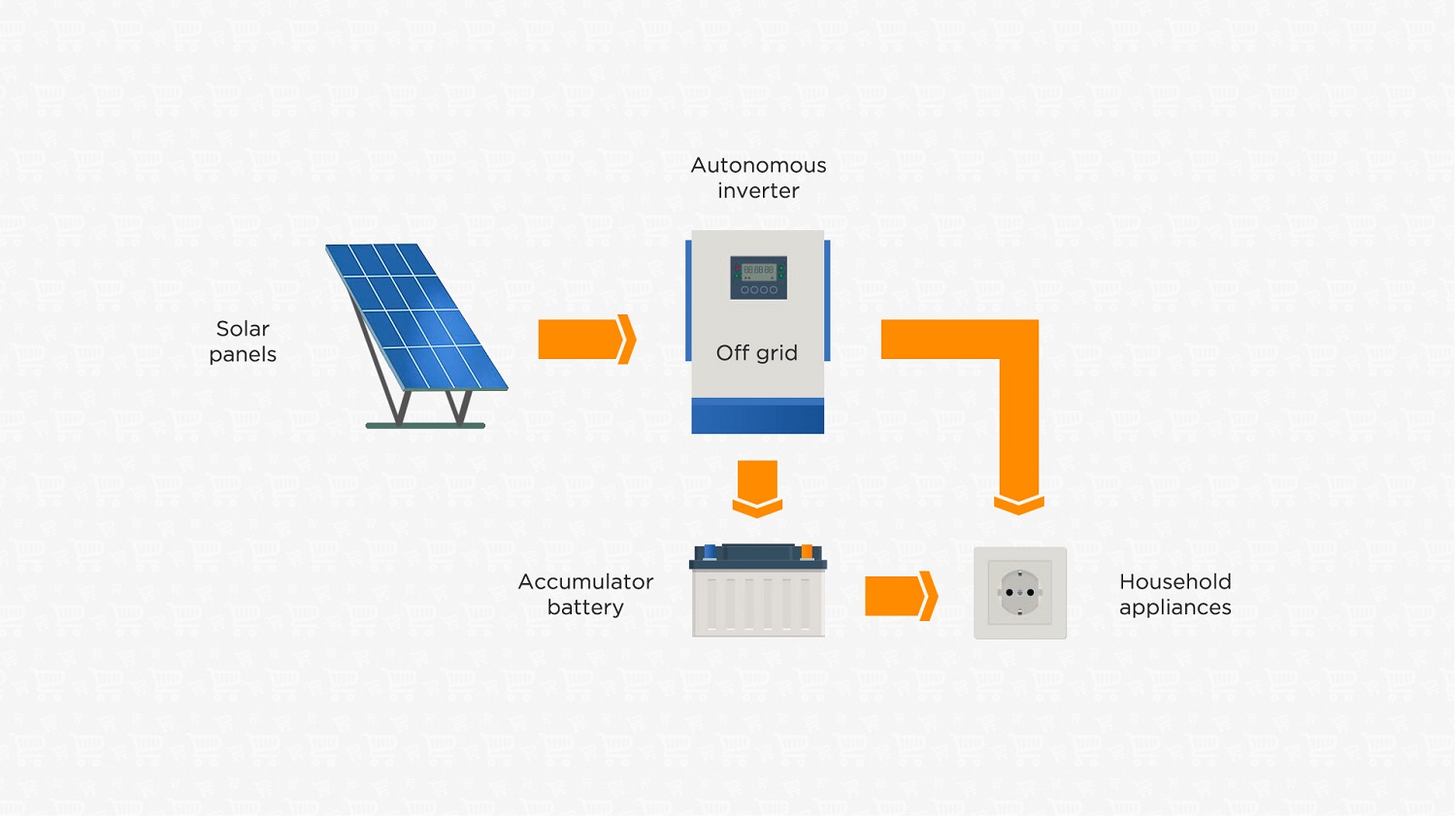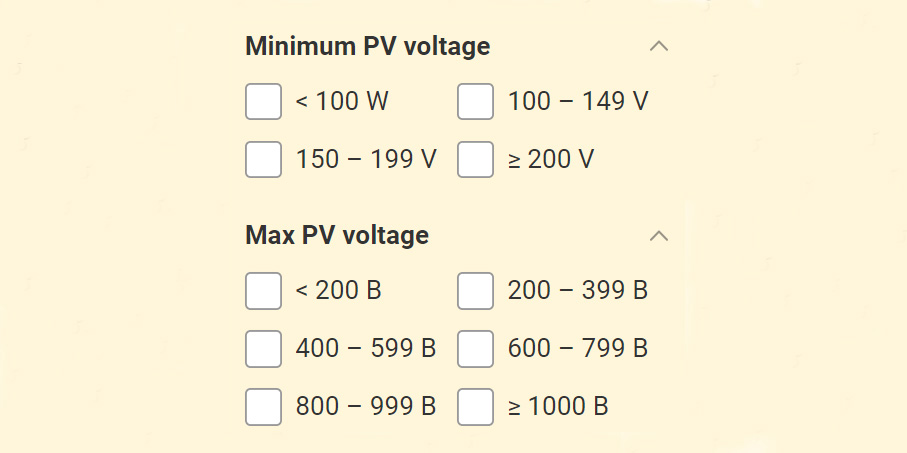How to choose a solar inverter
We independently test the products and technologies that we recommend.

1. Types of inverters
Inverters for solar power generation systems are divided into three major camps, which directly determine the tasks assigned to them.
Network (on-grid)
On-grid models operate synchronously with the centralized power grid. In simple terms, they convert solar energy into alternating power with the parameters of the general grid. The generated electricity can be used inside the house to power household appliances, and its surplus can be transferred to the centralized grid at a “green tariff” (this must be supported by the inverter itself, and you will also need to get a bidirectional electricity meter). If the electricity generated by solar panels does not cover the needs of the household, then part of the energy is taken from the general grid.
Grid-tie inverters are also commonly referred to as battery-less — the fact is that solar generation systems based on them do not have a battery buffer. That is, they are not capable of storing excess energy produced during periods of high productivity. On-grid grid-tie models have another priority — the economic benefit of using solar panels. Provided that excess generated electricity is regularly sold to the general grid, the solar system quickly pays for itself and allows for a significant reduction in electricity bills.

The downside of grid inverters is their strict connection to the general power grid and its parameters. If the standard characteristics deviate from the norm, there are power outages or interruptions in the centralized power supply, solar generation simply stops. On-grid models are not suitable for autonomous supply of housing with electricity from the sun.
Advantages of grid inverters:
- High efficiency (98% is the norm), since grid inverters do not waste excess energy on interaction with a conventional battery buffer.
- High "purity" of generated electricity.
- Efficient use of energy from solar panels.
- Economic benefit.
Disadvantages of grid inverters:
- Rigid connection to the centralized power grid.
- Lack of autonomy and backup options.
- Dependence on the parameters of the general network (unstable voltage or failures can affect the operation of the inverter).
Autonomous (off-grid)
Autonomous off-grid inverters do not need to be connected to the general power grid - they convert solar energy exclusively for household needs. The generated electricity can be consumed by household appliances and simultaneously accumulated in battery buffers for future use. Complete independence from the grid electricity will come in handy in case of frequent power outages, rolling blackouts and blackouts.
So, off-grid inverters operate in a closed internal power system. If there is excess generation, the surplus is accumulated in storage batteries, and they are supposed to be used in cloudy weather and at night. Battery assemblies for energy accumulation will have to be purchased separately - the inverter is connected to them directly through the corresponding terminals.

In simple terms, the operating principle of an autonomous inverter can be explained as follows. Let's assume that solar panels generate 1000 W of power, and 500 W of power is needed to power the conditional load at a given time - the inverter will ensure the transfer of half of the electricity generated to connected consumers, and the remaining part will be sent to charge the batteries. If it is necessary to power a load with a power of 1500 W, all generation will be transferred to the load and another 500 W will be taken from the battery buffer. In a similar way, you can "maneuver" during periods of reduced solar activity.
Advantages of autonomous inverters:
- Complete independence from the centralized power grid.
- Possibility of energy accumulation.
- Flexibility of load distribution.
Disadvantages of autonomous inverters:
- Dependent on weather conditions.
- Limited power.
- The need to purchase a battery buffer separately.
- Complexity of installation and configuration.
Hybrid
Hybrid inverters provide the best flexibility of operation. They are a kind of combination of network and autonomous models. That is, they not only convert direct power into alternating power, but can also accumulate excess electricity in a battery buffer and have the ability to give electricity to the centralized network at a "green tariff". The main thing is the finest adjustment of the consumption ratio. It is important to dwell on this point in more detail.
Hybrid inverters are best suited for competent automatic energy distribution. Thus, when there is a shortage of electricity generation from solar panels, such a converter takes the missing power from the battery or "mixes" it from the centralized network - all this is flexibly configured in the settings (with the support of the corresponding functions). The stage of supply from the battery can be skipped altogether, thus preserving the accumulated reserves. The inverter sends the excess generation to charge the battery buffer or transfers it to the general network - according to the selected priorities.

Advanced hybrid models are often equipped with a separate input for connecting a generator. The inverter can automatically turn the generator on and off when there is a shortage of electricity generation or to maintain an optimal battery charge level so that the system is fully ready at any time. Again, all these procedures can be fully automated - often through mobile applications or a convenient web interface.
Advantages of hybrid inverters:
- Ability to work with both standalone and networked systems.
- Flexibility of energy distribution.
- Efficient use of excess solar energy production.
- Possibility of energy accumulation.
- Control variability.
Disadvantages of hybrid inverters:
- High cost.
- Complexity of installation and configuration.
2. Working voltage, power and efficiency
An important aspect when choosing an inverter for solar power generation systems is the "fork" of permissible PV voltages (panel array). The operating range of the converter is between the starting voltage and maximum voltage points. If a lower voltage is supplied to the converter input, it simply will not start, while a higher voltage can cause rapid overheating of the inverter and failure. The maximum permissible voltage in the circuit is calculated for the limiting temperature of the solar battery of -25 °C, because the voltage increases precisely when the panel temperature drops and it is highly recommended not to exceed it. The minimum threshold is considered for the limiting temperature of the panels of +70 °C. Both obtained values determine the structure of the connection of solar batteries in a string, their permissible number and the connection method (serial, parallel, parallel-serial). In order not to calculate the parameters using special formulas, they are often given in the characteristics of specific inverters (min. PV voltage and max. PV voltage).

There are special search filters.
Output power is a fundamental characteristic of any inverter. The nominal power is indicated based on the total energy consumption of the entire load expected to be connected. It can be roughly estimated using the passports of electrical appliances or specialized power tables. And so that the inverter does not experience overloads, it is advisable to add at least 10 - 20% of reserve over the resulting power.
| Power tool | Household appliances | ||
|---|---|---|---|
| Consumer | Power, W | Consumer | Power, W |
| Electric jigsaw | 250-700 | Light bulbs | 5-50 |
| Electric sharpener | 300-1100 | TV | 100-400 |
| Drill | 400-800 | Fridge | 150-600 |
| Electric plane | 400-1000 | Computer | 400-750 |
| Perforator | 600-1400 | Vacuum cleaner | 1000-2000 |
| Grinding machine | 650-2200 | Hair dryer | 450-2000 |
| Circular saw | 750-1600 | Iron | 1000-2000 |
| High pressure pump | 2000-2900 | Toaster | 500-1000 |
| Electrical appliances | Coffee maker | 800-1500 | |
| Consumer | Power, W | Oven | 2000-3500 |
| Water pump | 500-900 | Electric kettle | 2000 |
| Electric motors | 550-3000 | Heater | 1000-2000 |
| Fan heater | 750-1700 | Electric stove | 1100-6000 |
| Compressor | 750-2800 | Boiler | 1500-2000 |
| Air conditioner | 1000-3000 | Microwave | 700-1000 |
| Circular saw | 18000-2100 | Washing machine | 1000-2500 |
In addition, it is worth paying attention to the peak power, which is much higher than the nominal. The fact is that some electrical appliances such as refrigerators, air conditioners or borehole pumps consume much more amperes in the first few seconds after starting than when operating in normal mode. The inverter must easily withstand such increased starting currents. Usually, the nominal and peak power are indicated in the characteristics of the converter.
The inverter's DC power depends on the characteristics of the solar panel array and fluctuates between 80 and 120% of the nominal output power. The fact is that it is usually recommended to slightly "overload" the inverter on the DC side, since the power of solar panels is set for STC conditions (standard test conditions reflecting the ideal operation of a solar panel), which are rarely achieved in practice. The vast majority of the time, solar panels operate at 80 - 90% of the set power, and during operation, their photocells degrade, which also leads to a drop in power. For a conventional 5 kW model, the optimal value of the total power of solar panels will be in the range of 4 to 6 kW (80% of 5 kW and 120% of the same 5 kW). Based on the obtained range, you can then calculate the number of panels in the solar system using special formulas.
As for the efficiency factor, it is advisable to give preference to models with an efficiency of about 90 - 95% or more. During the conversion and transmission of power from solar panels, some energy is inevitably lost, and another part is used for the inverter's own needs (for example, to ensure the operation of its cooling system). Losses over 10% are an unaffordable luxury for solar generation systems, where every watt counts.
3. Output signal geometry
Solar inverters produce voltage of various shapes: rectangular, quasi-sinusoidal and pure sine wave.

on the third one - a pure sine wave.
The first option is extremely rare and is completely unsuitable for powering inductive loads (refrigerators, air conditioners, power tools, etc.). Models with a quasi-sine waveform are slightly better - this is a kind of intermediate link. It is suitable for sensitive loads with a certain stretch, but it is also an order of magnitude cheaper than in the case of inverters with a pure sine wave. A smooth wave on the graph is a sign of voltage of the correct sinusoidal shape. It is compatible with all household electrical appliances, is characterized by resistance to loads and is suitable for power supply of delicate equipment.
4. Functionality
If the input power exceeds the capabilities of the device or it is necessary to increase the overall efficiency of the solar generation system, the parallel connection function of two or more inverters will come in handy. Converters connected in parallel are synchronized with each other via standard communication protocols (for example, Modbus or CAN). RS232, RS485, LAN (RJ-45) connectors serve as interfaces for coupling. In this case, the inverters work together, generating electricity with the same frequency and phase synchronization.
Parallel connection of inverters allows not only to increase the total power of electricity generation, but also to optimize the flow Rate of solar panels. Such a scheme allows connecting panels of different orientations and angles without reducing the overall efficiency of the system. In the case of one inverter , an MPPT controller will serve the same purpose, optimizing electricity generation under any changes in weather conditions. It determines the most optimal ratio of voltage and power taken from solar panels, thereby ensuring maximum flow Rate of individual chains of series-connected panels (strings). Several MPPT controllers are introduced into some schemes - each of their outputs is designed to connect one string.

Other interfaces on board the inverters can be represented by classic USB for configuring the equipment with a PC, Wi-Fi or Bluetooth communication modules. Wireless connection will serve to control the operation of the device from a paired smartphone or tablet. Flexible settings for monitoring and monitoring energy consumption are usually available in the mobile application or web interface.
Autonomous and hybrid inverters often have a UPS function - if solar generation is insufficient or the power supply from the centralized power grid is disconnected, such models automatically switch to autonomous operation mode from storage batteries. This ensures automatic backup of the connected load.
5. Features of operation
Inverters pay great attention to heat removal from internal components. For low-power models , a passive cooling system will be enough, and if the inverter is powerful and often loaded "to the fullest", it is worth taking a closer look at models with a cooler.
When placed outdoors or used in high humidity conditions, it is worth considering the moisture protection of the inverter case - IP65 and above. And when installing a solar converter inside residential premises - also the noise level. The source of noise can be the above-mentioned fan for blowing internal components, in addition, cheap Chinese inverters work very loudly and annoyingly.
Finally, it is extremely important to properly connect the inverter to the household network and not to exceed the peak load parameters. Although modern models are equipped with protection against overloads, voltage drops and short circuits, it is still not recommended to overload them.
6. Conclusion
To summarize, grid inverters are perfect for synchronous operation with the centralized power grid and selling excess electricity generation at the "green tariff". Operation in a closed power supply circuit with electricity accumulation in battery buffers is the prerogative of autonomous inverters. And hybrid inverters, operating both in the autonomous and central grids, provide maximum flexibility.
Articles, reviews, useful tips
All materials




















































































